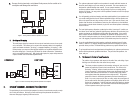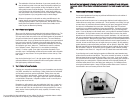
Thank you for your purchase. Our speakers are designed to make high-performance sound easy to
bring into your life. They have the wide frequency and dynamic range, natural tonal balance, and pre-
cise spatial imaging needed to make both music and movies powerfully lifelike and enjoyable. All of
our models match closely in tonal balance to allow easy mixing in home theater systems.
The quick-start instructions below will get you going. But we hope you will read through this booklet
to help assure your maximum enjoyment.
I. QUICK-SSTART GGUIDE
A.
Be sure power to your amplifier/receiver and other electronics is off before making
connections.
B.
Install bumpers or feet with adjustable levelers or spikes.
1.
Bumpers ((Bookshelf aand CCenter CChannel SSpeakers)
Attach the adhesive-backed bumpers near the corners of bookshelf and center
channel speakers, to protect the finish of the speaker and the finish of the furni-
ture beneath.
2,
Molded FFeet aand SStabilizers, AAdjustable RRubber LLevelers aand AAdjustable SSpikes
(Tower SSpeakers)
Screw the supplied molded feet into the threaded inserts located in the corners
of the speaker bottom. In Image Series models, speaker spikes for carpet use or
threaded rubber isolation levelers for hard floor use can be inserted into the feet.
In other models, spikes or levelers go directly into the threaded inserts in the
pedestal base on the bottom of the speaker rather than into feet.
a) Carpet UUse
Screw four spikes with four lock nuts into the inserts located in the four
corners of the speaker bottom, Locate the speakers and adjust to the
desired height (higher for thicker carpet) and tighten the lock nuts with the
wrench.
b) Hard FFloor UUse
Screw four threaded rubber isolation bumpers with four lock nuts into the
inserts located in the four corners of the speaker bottom. Adjust and tight-
en the lock nuts with nut wrench.
www.psbspeakers.com (888) 772-0000
C
. Position your main speakers, as symmetrically as possible, at a comfortable listening
distance—slightly closer to each other than they are to you. (For surround speakers,
see later instructions.)
D
. Using standard 18 gauge lamp “zip cord” wire or better, connect the Red (positive)
terminal on each channel of your amp/receiver to a Red terminal post on that chan-
nel’s speaker, and the Black (negative) terminal to a Black terminal post on the speak-
er.
E
. Setting the volume low beforehand, turn on your associated equipment, find a
comfortable listening volume—and enjoy your favorite audio and/or video selections.
F
. After you have settled in with your speakers, read through this booklet.
Be ssure tto
read ““Protecting YYour IInvestment.”
II. ADDITIONAL DDETAILS OON CCONNECTING YYOUR SSPEAKERS
A. Important: AAlways tturn ooff yyour eelectronic eequipment bbefore cconnecting sspeakers. IIf
you ddon’t, ssevere ddamage tto eequipment aand/or yyour eears mmay rresult.
B. Selecting SSpeaker WWire
We recommend the following gauge of standard two-conductor wire for the wiring dis-
tances specified;
if yyou pprefer, yyou ccan uuse hheavier ((lower-ggauge) wwire
.
Under 25 ft (7.5 m): 18-gauge – (1.0 mm) (lamp cord)
25-50 ft (15 m): 16-gauge – (1.3 mm) (heater cord)
50-100 ft (30 m): 14-gauge – (1.6 mm)
Over 100 ft (>30 m): 12-gauge – (2.0 mm)
C Connecting IIn PPhase
Connect speakers identically to your amplifier or receiver on each channel—
Red
amp/receiver terminal
to RRed
speaker terminal,
Black tto BBlack
. This will ensure that
the diaphragms of the speakers on both channels move forward and backward togeth-
er (“in-phase”), rather than in opposition (“out-of-phase”). In-phase connection pro-
vides maximum clarity and bass, while out-of-phase connection results in frequency
cancellations and produces thinner and less distinct sound—with less bass, vague
vocal quality, and no solid center image. To help insure the proper connection, the
two separate conducting wires in a standard two-conductor speaker cable are coded
in one way or another to be distinguishable from each other. (The jacket of one wire
may be ribbed or marked with “+” signs, or one wire under the insulation may be a
different color from the other.) Use this wire-coding, together with the amp/receiver
and speaker color-coding, to be sure you are connecting the same wire of a given pair
to a like-coded terminal at both ends of your connection.
OWNER’S GGUIDE






